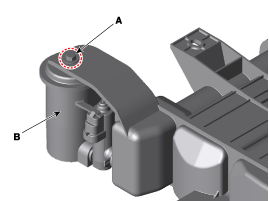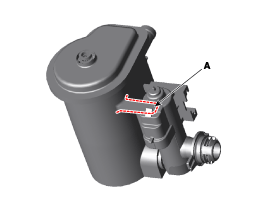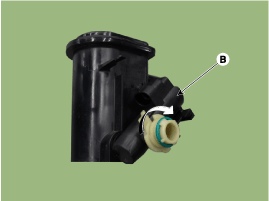Hyundai Elantra: Engine Control System / Canister Close Valve (CCV) Repair procedures
Hyundai Elantra AD (2016-2020) Service Manual / Engine Control/Fuel System / Engine Control System / Canister Close Valve (CCV) Repair procedures
| Inspection |
| 1. |
Turn the ignition switch OFF. |
| 2. |
Disconnect the CCV connector. |
| 3. |
Measure resistance between the CCV terminal 1 and 2. |
| 4. |
Check that the resistance is within the specification.
|
| 5. |
Disconnect the vapor hose connected with the canister from the CCV. |
| 6. |
Connect a vacuum pump to the nipple. |
| 7. |
Ground the CCV control line and apply battery voltage to the CCV power supply line. |
| 8. |
Apply vacuum and check the valve operation.
|
| Removal |
| 1. |
Turn ignition switch OFF and disconnect the battery negative (-) terminal. |
| 2. |
Remove the canister assembly.
(Refer to Emission Control System - "Canister") |
| 3. |
Remove the installation bolt (A), and then remove the air filter (B).
|
| 4. |
Release the lever (A), and then separate the canister close
valve (B) from the fuel tank air filter after rotating it in the
direction of the arrow in the figure.
|
| 5. |
Install a new fuel tank air filter in accordance with the reverse order.
|
| Installation |
|
| 1. |
Installation is reverse of removal. |
 Canister Close Valve (CCV) Schematic Diagrams
Canister Close Valve (CCV) Schematic Diagrams
Circuit Diagram
...
 Variable Charge Motion Actuator (VCMA) Description and Operation
Variable Charge Motion Actuator (VCMA) Description and Operation
Description
The Variable Charge Motion Actuator (VCMA) is installed on the inlet of the intake manifold.
It consists of a DC motor which actuates the VCM valve and a position sensor which detects ...
Other information:
Hyundai Elantra AD (2016-2020) Owners Manual: Fuel Filler Door
Opening the fuel filler door
The fuel filler door must be opened from inside the vehicle by pulling up the
fuel filler door release lever.
1. Turn the engine off. Locate the fuel filler door release lever on the floor
on the left side of the driver seat.
2. Pull up on the release lever.
...
Hyundai Elantra AD (2016-2020) Service Manual: CVVT & Camshaft Components and Components Location
Components
1. Camshaft bearing cap2. Camshaft front bearing cap3. Exhaust camshaft4. Intake camshaft5. Exhaust CVVT assembly6. Intake CVVT assembly
...
© 2018-2025 www.helantraad.com




